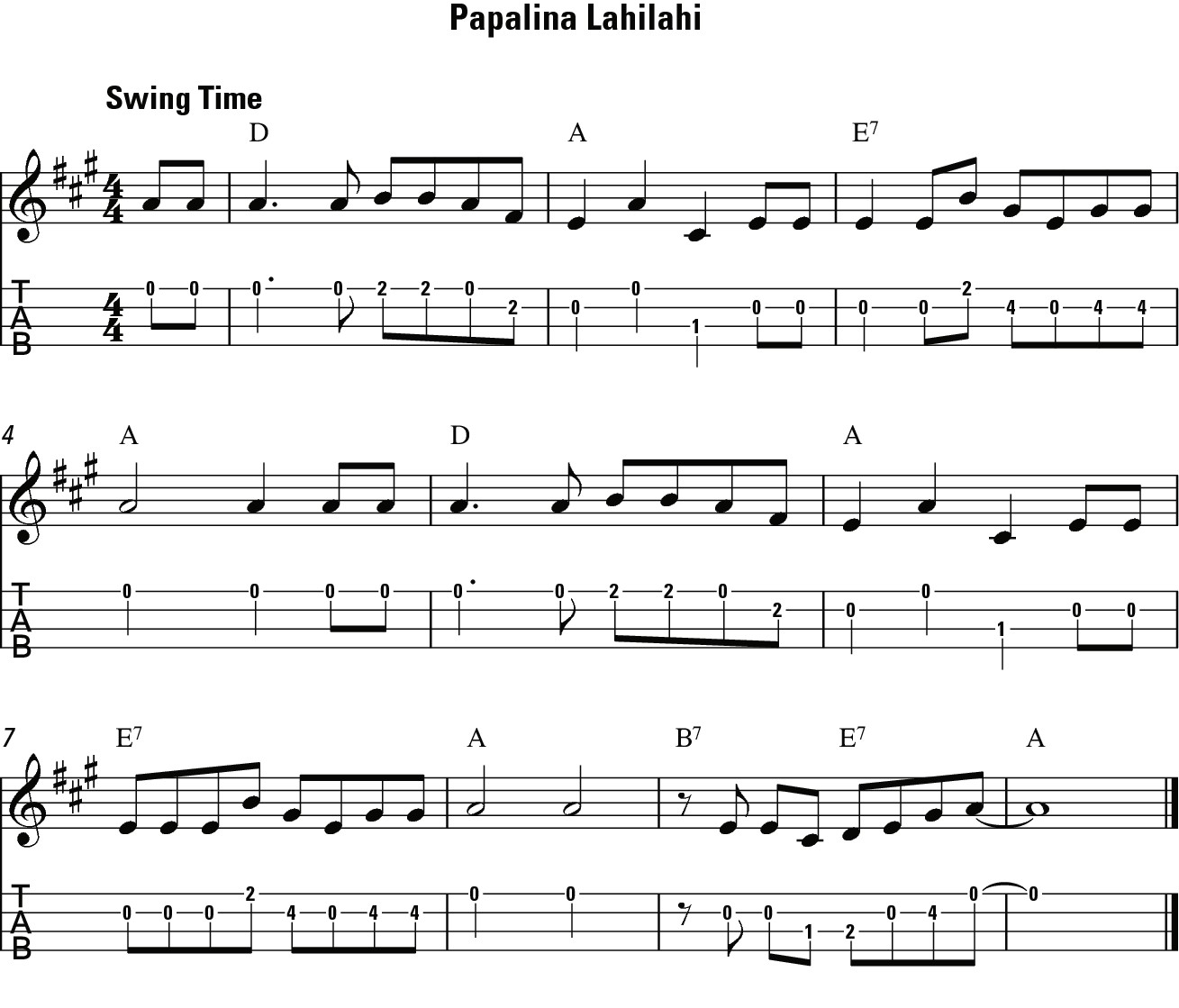Ukulele For Dummies (55 page)
Read Ukulele For Dummies Online
Authors: Alistair Wood
The triplet strum requires the use of your thumb and index finger. Start by making your hand into a loose fist and placing it in the usual strumming position. Then flick your index finger down across the strings (the first strum). Now follow through and strum down with your thumb (second strum) and rotate your wrist. Then bring your index finger back up the strings with a reverse flick (third strum) so that you're back in the position you started. Figure 13-5 shows the strumming notation for this technique.
Turning Around, Hawaiian-style
The
turnaround
(the final part of a chord progression that leads back to the start) is one of Hawaiian music's most distinctive features.
Progressing to the Hawaiian turnaround
 In most Hawaiian tunes you hear a sequence of chords that leads you very naturally from the end of one sequence chords back to the beginning. I describe this part, known as a
In most Hawaiian tunes you hear a sequence of chords that leads you very naturally from the end of one sequence chords back to the beginning. I describe this part, known as a
turnaround
, in this section.
 The Hawaiian turnaround is known as a II7âV7âI progression. In the key of C, this is D7âG7âC, as shown in Figure 13-4 (Track 76, Part 1). This is an excellent place to use the triplet strum as shown in Figure 13-5 (Track 76, Part 2).
The Hawaiian turnaround is known as a II7âV7âI progression. In the key of C, this is D7âG7âC, as shown in Figure 13-4 (Track 76, Part 1). This is an excellent place to use the triplet strum as shown in Figure 13-5 (Track 76, Part 2).
You can build your own Hawaiian turnaround using the chord families from Chapter 9. For example, in the key of A the ii chord is Bm, the V chord is E and the I chord is A. To create the Hawaiian turnaround, you take the minor II chord and change it to a major 7 chord (in this case changing Bm to B7). So the II7âV7âI progression is B7âE7âA.
Figure 13-4:
Hawaiian turnaround in C notation.

Figure 13-5:
Hawaiian turnaround with triplet strumming notation.

Soloing the Hawaiian turnaround
 Typically, the turnaround in a Hawaiian song is not sung, which provides the perfect opportunity to show off with a little soloing! However, a well-established form exists to these little solos. Figure 13-6 (Track 77, Part 1) shows the turnaround in its most basic form (in the key of A).
Typically, the turnaround in a Hawaiian song is not sung, which provides the perfect opportunity to show off with a little soloing! However, a well-established form exists to these little solos. Figure 13-6 (Track 77, Part 1) shows the turnaround in its most basic form (in the key of A).
Figure 13-6:
Basic turnaround solo tab.

 You can adapt and ornament this passage with a few hammer-ons and pull-offs (which I describe in Chapter 10): check out Figure 13-7 and Track 77, Part 2.
You can adapt and ornament this passage with a few hammer-ons and pull-offs (which I describe in Chapter 10): check out Figure 13-7 and Track 77, Part 2.
Figure 13-7:
Advanced turnaround solo notation.

 Turnarounds are so popular that performers often play them twice for an extra bit of widdling. You can play the same turnaround twice, add your own variations or, as in Figure 13-8 (Track 77, Part 3), combine the two previous turnarounds with a linking phrase. Get creative and try out your own variations.
Turnarounds are so popular that performers often play them twice for an extra bit of widdling. You can play the same turnaround twice, add your own variations or, as in Figure 13-8 (Track 77, Part 3), combine the two previous turnarounds with a linking phrase. Get creative and try out your own variations.
Figure 13-8:
Double turnaround tab.

One tune that uses this turnaround is âPapalina Lahilahi' (see Figure 13-9; Track 78). Feel free to use any of the turnarounds that I describe in this section or invent one of your own.
Figure 13-9:
âPapalina Lahilahi' tab.

Stretching Out to Play âAlekoki'